Application of a Local Dynamic Model of Large Eddy Simulation to a Marine Propeller Wake
Abstract
1. Introduction
- Perform a LES simulation with a local dynamic k-equation eddy-viscosity model (named LES-LDKSGS in this paper) and a RANS simulation with a standard model (named RANS-kEpsilon, just for comparison with LES-LDKSGS) for flow over a submarine propeller at design and off-design advance ratios;
- Evaluate the ability of LES-LDKSGS model to capture the complex evolution of propeller wake, and compare the results of LES-LDKSGS model with the results of PIV measurements, dynamic algebraic model (LES-DASGS, also called LES-DSM) and RANS-kEpsilon model;
- Study the flow field evolution mechanics of the propeller and the origin of loads on blades from the perspective of engineering applications;
- Discuss vortex identification of the wake in detail from an academic point of view.
2. Numerical Experiments
2.1. Governing Equations of Flow
2.2. LES Models
2.3. Geometry and Performance Characteristics of Propeller
2.4. Computational Domain and Meshing
2.5. Initial and Boundary Conditions
- Position of horizontal dashed lines: = 0.7, 0.8, 0.9, 1, 1.1, 1.2, 1.3, 1.5, 2, 3, 4, 5, 6.;
- Position of vertical double-dashed lines: , 0.06, 0.08, 0.1, 0.115, 0.5, 1, 2, 3, 4, 5, 6, 7, 7.8.
2.6. Numerical Method
3. Verification and Comparison
3.1. Verification of Adequate Domain Size
3.2. Mean Force Comparison
3.3. Compare with PIV Data
3.4. Compare with Different Advance Ratios
4. Results and Discussion
4.1. Time History of Force
4.2. PSD of Force
- Step1: cut off a tail or add some to the original data to make the sequence length , then the time series is given as discrete samples ;
- Step2: use the appropriate “data window” to correct , i.e., ;
- Step3: fast algorithm to calculate the discrete Fourier transform of the sequence of real numbers , that is ;
- Step4: get power spectrum estimate where and .
4.3. Circulation
4.4. Instantaneous
4.5. Mean Axial Velocity Profiles
4.6. Mean Square Velocity Fluctuations
4.7. Vortex Structures
5. Summary and Conclusions
- For mean thrust and torque coefficients LES-LDKSGS (used in our article) results show good agreements with the WT (Jessup et al. 2006) results, but less than RANS-kEpsilon results (using the same mesh as in LES-LDKSGS simulation, note there is actually no need of too refinement grid for RANS-kEpsilon simulation) under the same computing cost, which implies that if your concern is only for mean force of the propeller the LES method may be not your best choice considering cost;
- The results of LES-LDKSGS (used in our article) with a lower computational cost is comparable to the results of LES-DASGS [3], which shows the superiority of the LES-LDKSGS model than the LES-DASGS model to some extent;
- The evolution mechanism of propeller wake is well captured by the LES-LDKSGS model, including the interaction mechanism between the tip vortex and the trailing edge vortex that dominate the evolution of propeller wake from near to far fields, although this mechanism actually depends on the geometry and operating conditions of the propeller;
- The vortex CSs of the propeller wake, including the size of the vortex core, are visualized using different criterions to give more insight.
Author Contributions
Funding
Institutional Review Board Statement
Informed Consent Statement
Conflicts of Interest
Abbreviations
| DNS | direct numerical simulation |
| LES | large eddy simulation |
| RANS | Reynolds averaged Navier-Stokes |
| PIV | particle image velocimetry |
| WT | water tunnel |
| OW | open water towing tank |
| SGS | subgrid-scale |
| PDE | partial differential equation |
| GAAM | geometric aggregated algebraic multi-grid |
| TA | time averaging |
| SA | spatial averaging |
| EA | ensemble averaging |
| IC | the initial condition |
| BC | the boundary condition |
| LES-LDKSGS | a local dynamic one-equation subgrid-scale LES model |
| LES-DKSGS | a dynamic one-equation subgrid-scale LES model |
| LES-DASGS | the dynamic algebraic LES model |
| LES-DSM | the dynamic Smagorinsky LES model |
| WALE | wall adaptive local eddy viscosity model |
| DDES | delayed discrete eddy simulation |
| RANS-kEpsilon | a standard k-varepsilon model of Reynolds averaged Navier-Stokes equations |
| SIMPLE | Semi-Implicit Method for Pressure-Linked Equations |
| PISO | Pressure Implicit with Splitting of Operators |
| CS | coherent structure |
| DTMB | David Taylor Model Basin |
| Ma | Mach number |
| 3D | three-dimensional |
| Co | Courant number |
| Re | Reynolds number |
| TKE | turbulent kinetic energy |
| ITTC | International Towing Tank Conference |
References
- Posa, A.; Broglia, R.; Felli, M.; Cianferra, M.; Armenio, V. Hydroacoustic analysis of a marine propeller using large-eddy simulation and acoustic analogy. J. Fluid Mech. 2022, 947, A46-1. [Google Scholar] [CrossRef]
- Nicoud, F.; Ducros, F. Subgrid-scale stress modelling based on the square of the velocity gradient tensor. Flow Turbul. Combust. 1999, 62, 183–200. [Google Scholar] [CrossRef]
- Kumar, P.; Mahesh, K. Large eddy simulation of propeller wake instabilities. J. Fluid Mech. 2017, 814, 361–396. [Google Scholar] [CrossRef]
- Hyunchul, J.; Krishnan, M. Large eddy simulation of flow around a reverse rotating propeller. J. Fluid Mech. 2013, 729, 151–179. [Google Scholar]
- Germano, M.; Piomelli, U.; Moin, P.; Cabot, W.H. A dynamic subgrid-scale eddy viscosity model. Phys. Fluids A 1991, 3, 1760. [Google Scholar] [CrossRef]
- Lilly, D.K. A proposed modification of the Germano subgrid-scale closure method. Phys. Fluids A Fluid Dyn. 1992, 4, 633. [Google Scholar] [CrossRef]
- Martin, V.; Krishnan, M. Large eddy simulation of crashback in marine propellers. In Proceedings of the 44th AIAA Aerospace Sciences Meeting and Exhibit, Reno, NV, USA, 9–12 January 2006. [Google Scholar] [CrossRef]
- Liu, C.B.; Li, J.; Li, Y.; Wang, T.J. Scale-resolving simulation and particle image velocimetry validation of the flow around a marine propeller. J. Zhejiang-Univ.-Sci. (Appl. Phys. Eng.) 2019, 20, 553–563. [Google Scholar] [CrossRef]
- Ning, Z.; Richad, W.; Hu, H. An experimental study on small UAV propellers with serrated trailing edges. In Proceedings of the 47th AIAA Fluid Dynamics Conference, Denver, CO, USA, 5–9 June 2017. [Google Scholar] [CrossRef]
- Seo, J.; Seol, D.M.; Han, B.; Rhee, S.H. Turbulent wake field reconstruction of VLCC models using two-dimensional towed underwater PIV measurements. Ocean. Eng. 2016, 118, 28–40. [Google Scholar] [CrossRef]
- Liao, Q.; Wang, B.B.; Wang, P.F. In situ measurement of sediment resuspension caused by propeller wash with an underwater particle image velocimetry and an acoustic doppler velocimeter. Flow Meas. Instrum. 2015, 41, 1–9. [Google Scholar] [CrossRef]
- Paik, B.G.; Kim, J.; Park, Y.; Kim, K.; Yu, K. Analysis of wake behind a rotating propeller using PIV technique in a cavitation tunnel. Ocean. Eng. 2007, 34, 594–604. [Google Scholar] [CrossRef]
- Wesseling, P. Principles of Computational Fluid Dynamics; Springer: Berlin/Heidelberg, Germany, 2001. [Google Scholar]
- Batchelor, G.K. An Introduction to Fluid Dynamics; Cambridge University Press: Cambridge, UK, 2000. [Google Scholar]
- Richardson, L.F.; Lynch, P. Weather Prediction by Numerical Process; Cambridge University Press: Cambridge, UK, 1922. [Google Scholar]
- Tennekes, H.; Lumley, J.L. A First Course in Turbulence; MIT Press: Cambridge, MA, USA, 1972. [Google Scholar]
- Kolmogorov, A.N. The local structure of turbulence in incompressible viscous fluid for very large Reynolds numbers. Proc. R. Soc. Math. 1991, 434, 9–13. [Google Scholar]
- Kolmogorov, A.N. Dissipation of energy in isotropic turbulence. Dokl. Akad. Nauk SSSR 1941, 32, 325–327. [Google Scholar]
- Reynolds, O. On the dynamical theory of incompressible viscous fluids and the determination of the criterion. Proc. R. Soc. Lond. 1895, 186, 123–164. [Google Scholar]
- Sagaut, P. Large Eddy Simulation for Incompressible Flows: An Introduction; Springer: Berlin/Heidelberg, Germany, 2006. [Google Scholar]
- Smagorinsky, J. General circulation experiments with the primitive equations. Mon. Weather. Rev. 1963, 91, 99–164. [Google Scholar] [CrossRef]
- Meneveau, C.; Lund, T.S.; Cabot, W.H. A Lagrangian dynamic subgrid-scale model of turbulence. Cent. Turbul. Res. Summer Program 1994, 319, 353–385. [Google Scholar] [CrossRef]
- Kim, W.W.; Menon, S. A new dynamic one-equation subgrid-scale model for large eddy simulation. In Proceedings of the 33rd Aerospace Sciences Meeting and Exhibit, Reno, NV, USA, 9–12 January 1995. [Google Scholar]
- Ghosal, S.; Lund, T.S.; Moin, P. A local dynamic model for large eddy simulation. Annu. Res. Briefs 1992. Available online: https://www.researchgate.net/publication/234395580_A_local_dynamic_model_for_large_eddy_simulation (accessed on 3 July 2023).
- Yoshizawa, A. Bridging between eddy-viscosity-type and second-order turbulence models through a two-scale turbulence theory. Phys. Rev. E 1993, 48, 273–281. [Google Scholar] [CrossRef]
- Menon, S.; Yeung, P.K. Analysis of Subgrid Models Using Direct and Large-Eddy Simulations of Isotropic Turbulence. 1995. Available online: https://www.researchgate.net/publication/4686899_Analysis_of_subgrid_models_using_direct_and_large-eddy_simulations_of_isotropic_turbulence (accessed on 3 July 2023).
- Menon, S.; Yeung, P.K.; Kim, W.W. Effect of subgrid models on the computed interscale energy transfer in isotropic turbulence. Comput. Fluids 1996, 25, 165–180. [Google Scholar] [CrossRef]
- Liu, S.W.; Meneveau, C.; Katz, J. On the properties of similarity subgrid-scale models as deduced from measurements in a turbulent jet. J. Fluid Mech. 1994, 275, 83–119. [Google Scholar] [CrossRef]
- Bridges, D.H. Detailed Study of the Flowfield of a Submarine Propeller during a Crashback Maneuver; Mississippi State University: Starkville, MI, USA, 2004. [Google Scholar]
- Carlton, J.S. Marine Propellers and Propulsion; Elsevier: Amsterdam, The Netherlands, 2007. [Google Scholar]
- Segalini, A.; Inghels, P. Confinement effects in wind-turbine and propeller measurements. J. Fluid Mech. 2014, 756, 110–129. [Google Scholar] [CrossRef]
- Patankar, S.V.; Spalding, D.B. A calculation procedure for heat, mass and momentum transfer in three-dimensional parabolic flows. J. Heat Mass Transf. 1972, 15, 1787–1806. [Google Scholar] [CrossRef]
- Patankar, S.V. Numerical Heat Transfer and Fluid Flow; Series in Computational Methods in Mechanics and Thermal Sciences; Taylor & Francis: Abingdon, UK, 1980. [Google Scholar]
- Issa, R.I. Solution of the implicitly discretised fluid flow equations by operator-splitting. J. Comput. Phys. 1991, 62, 40–65. [Google Scholar] [CrossRef]
- The OpenFOAM Foundation Ltd. Available online: https://www.openfoam.org.2011 (accessed on 1 October 2011).
- Jinhee, J.; Fazle, H. On the identification of a vortex. J. Fluid Mech. 1995, 285, 69–94. [Google Scholar]
- Lamb, H. Hydrodynamics; Cambridge University Press: Cambridge, UK, 1975. [Google Scholar]

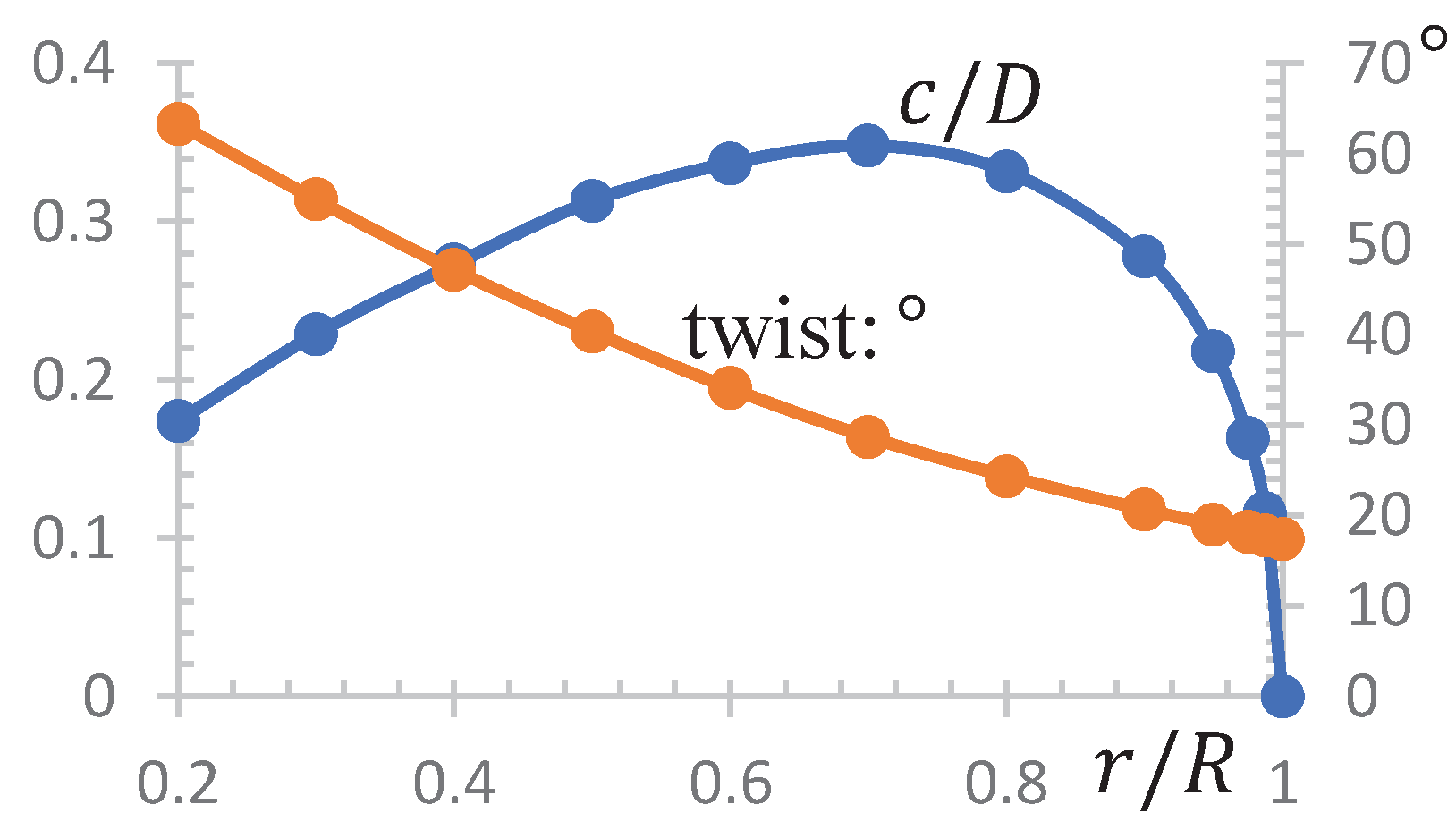
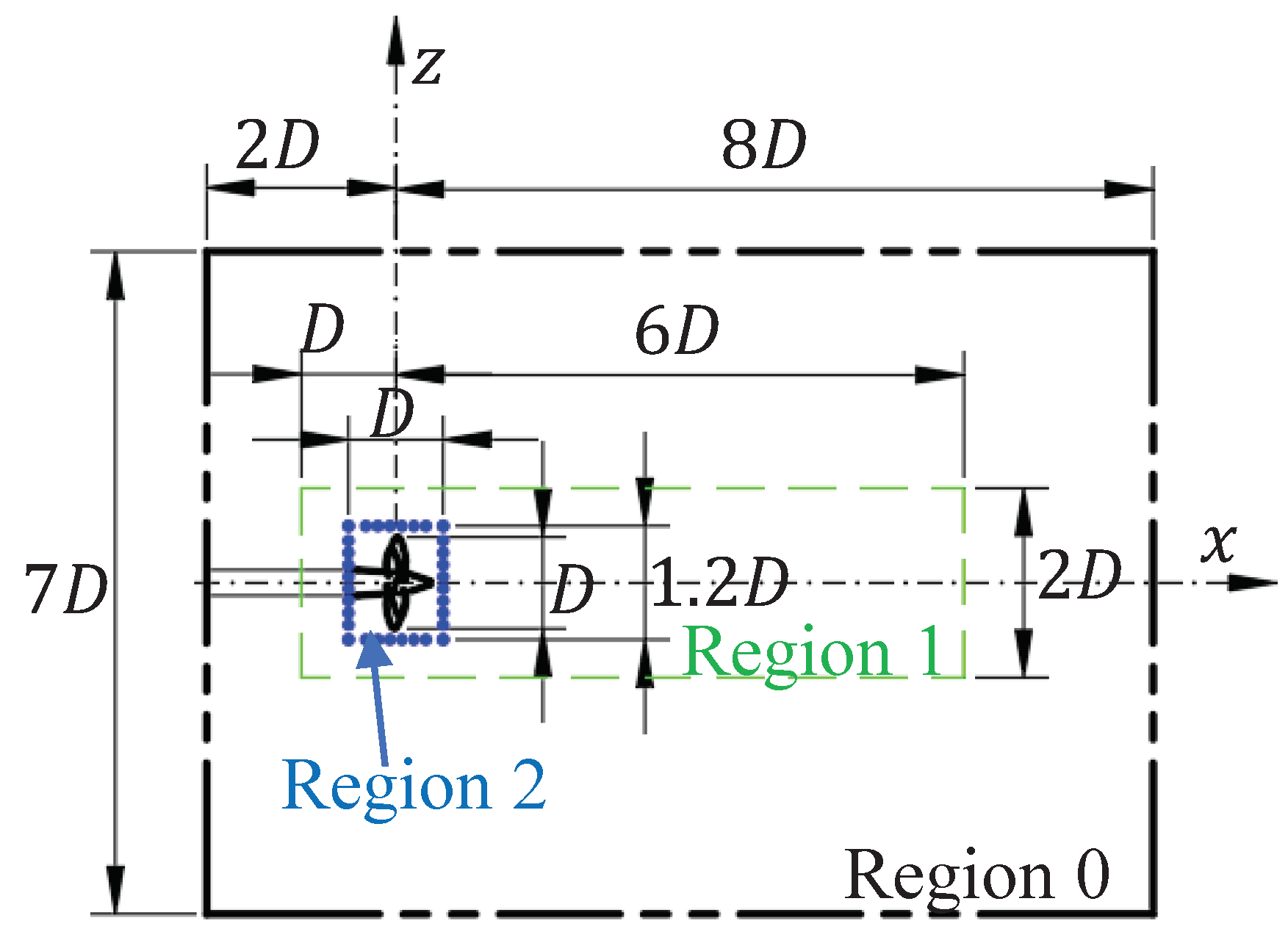



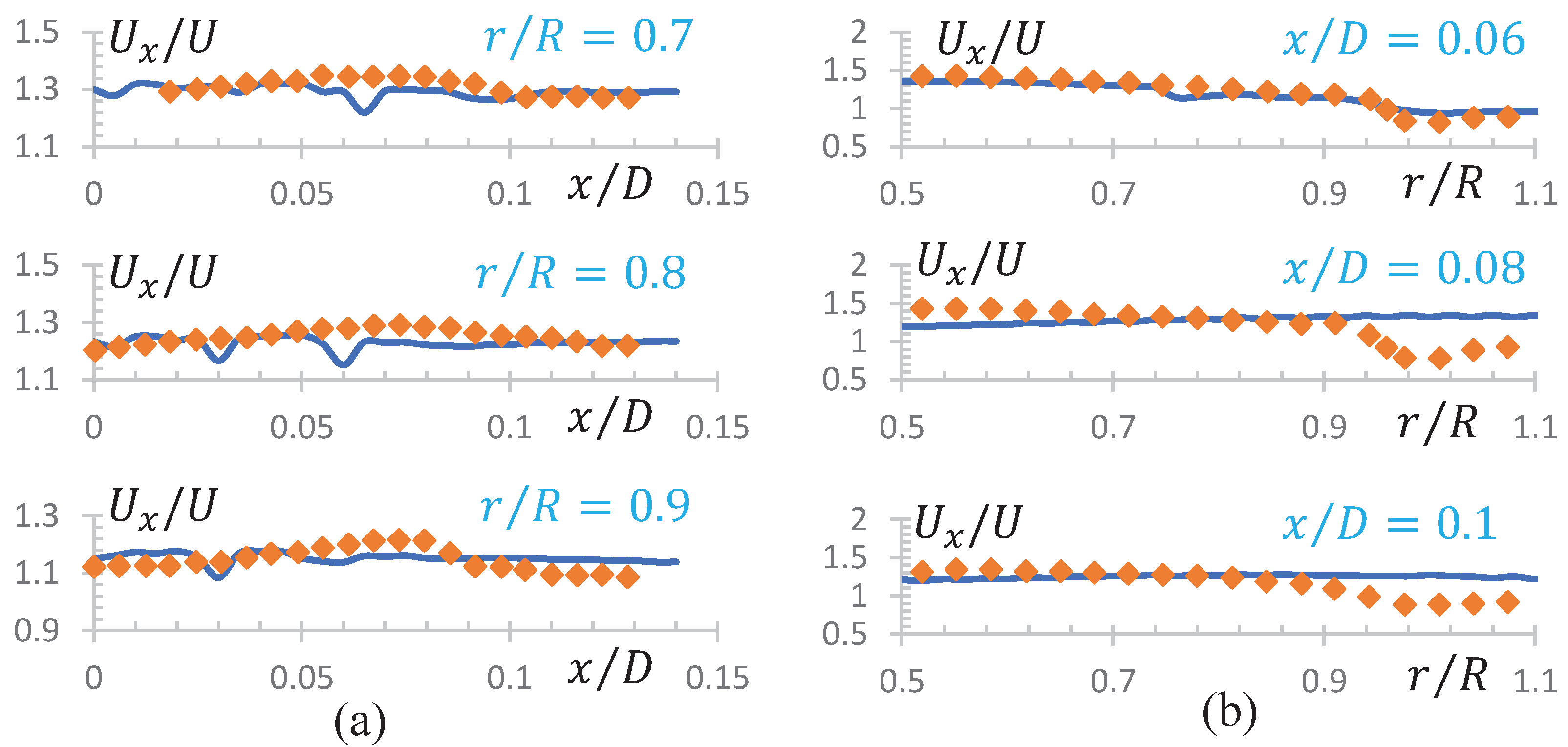
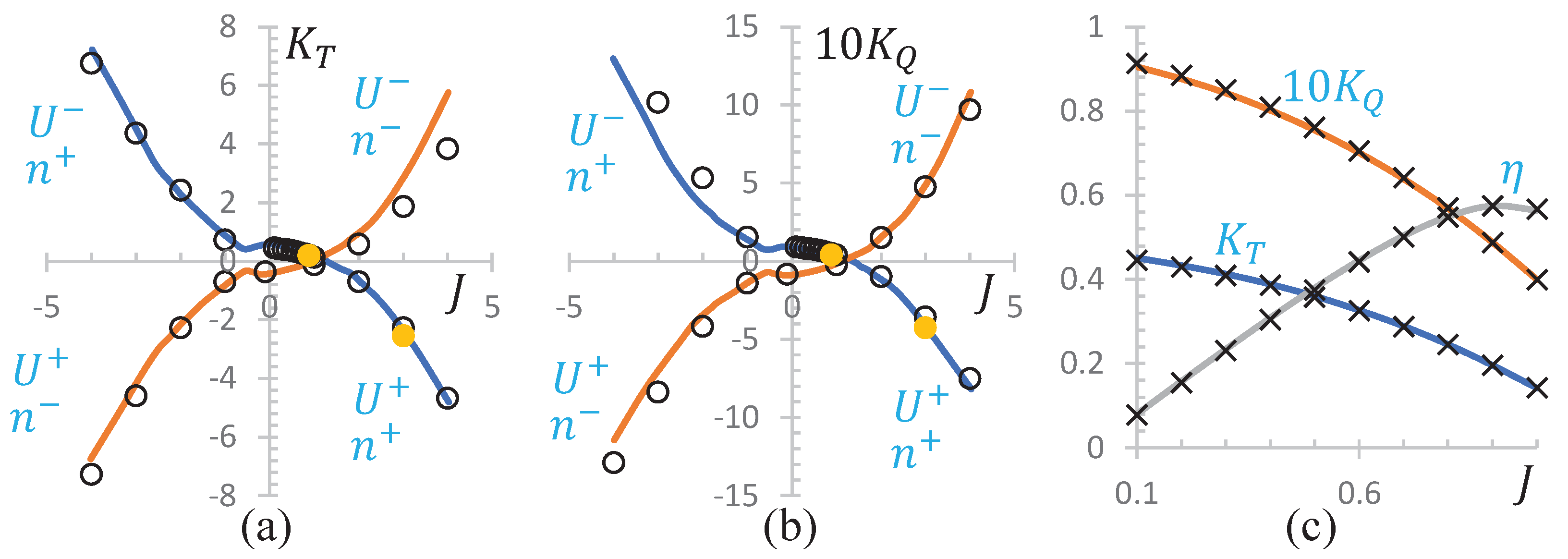
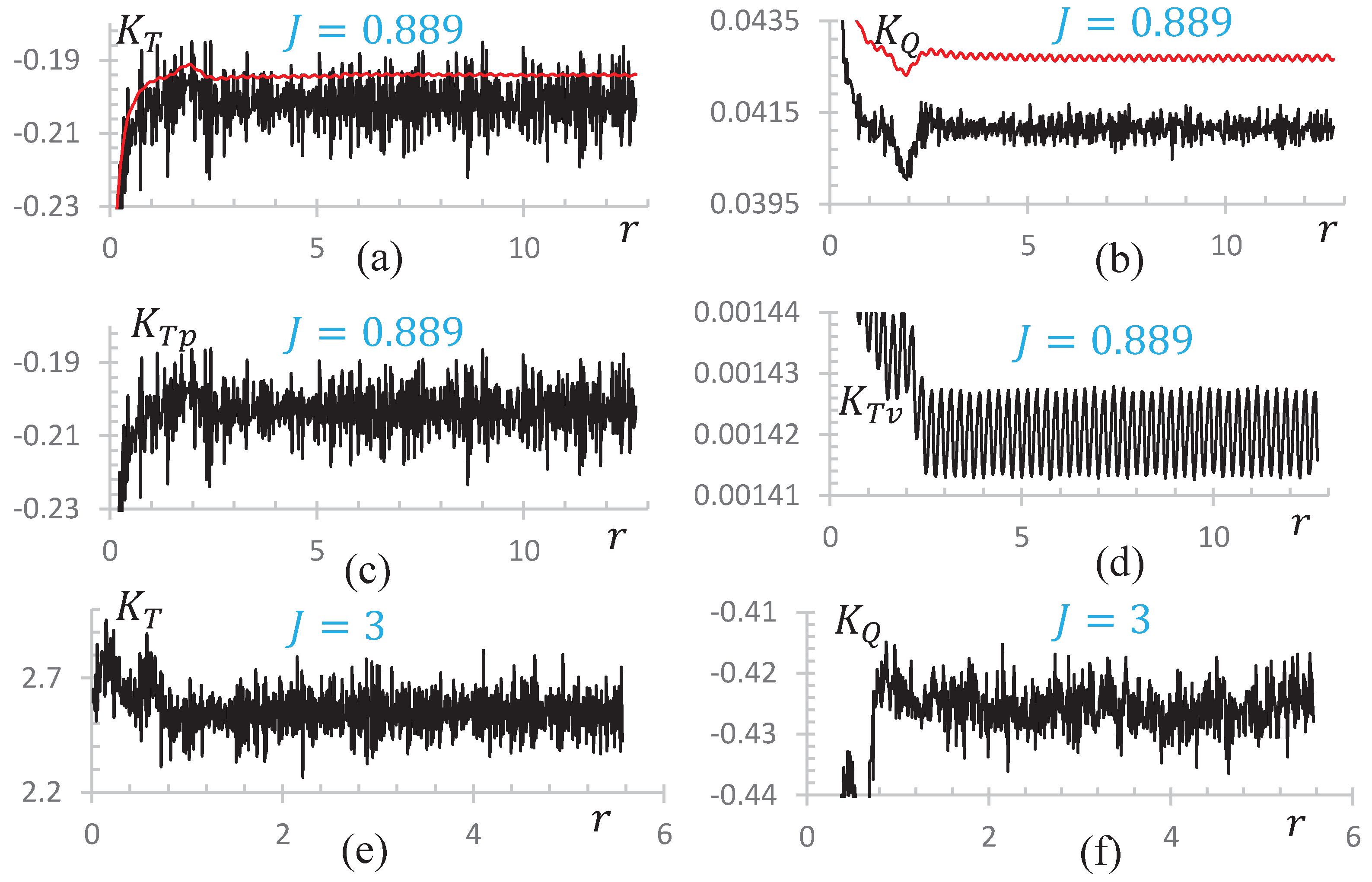
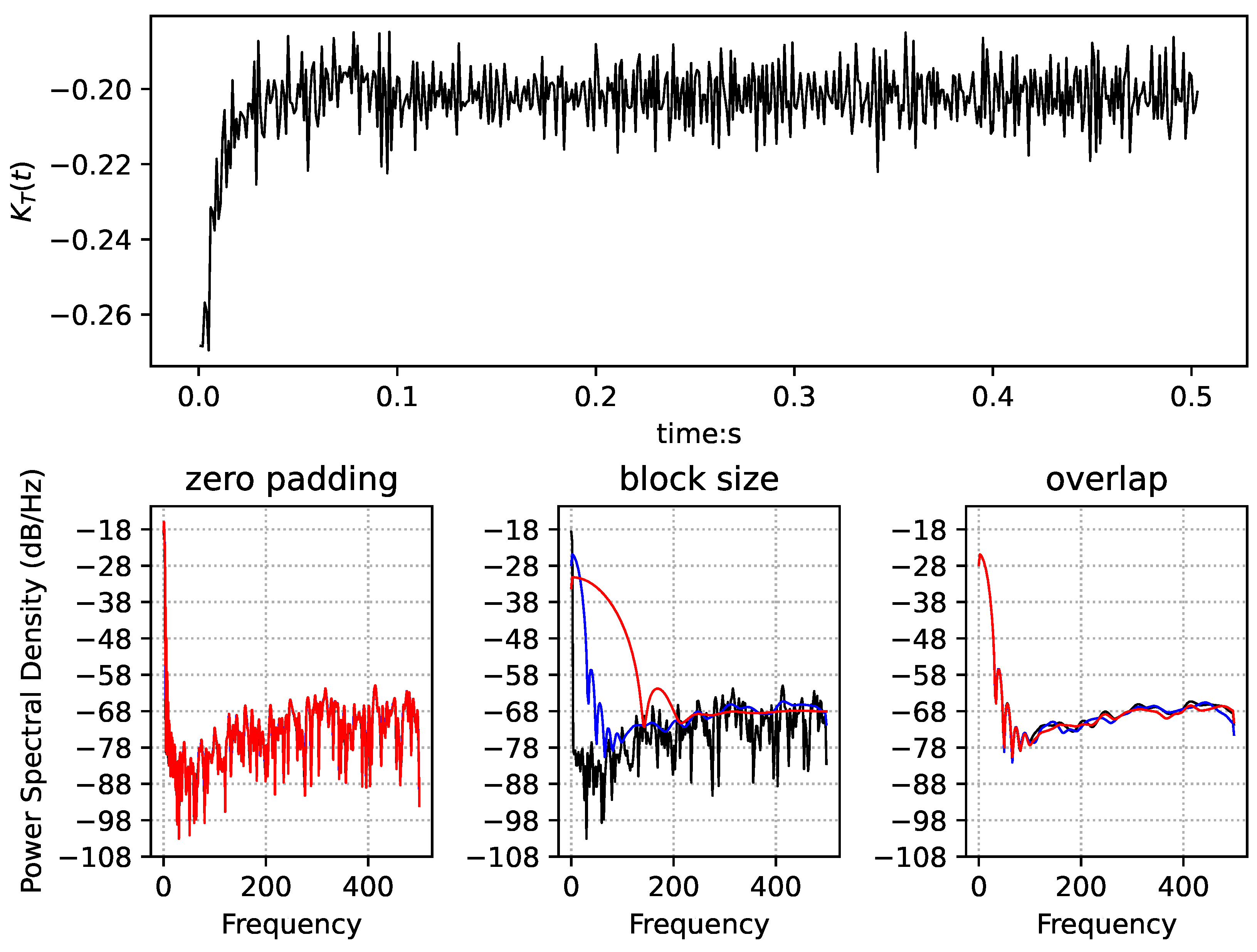



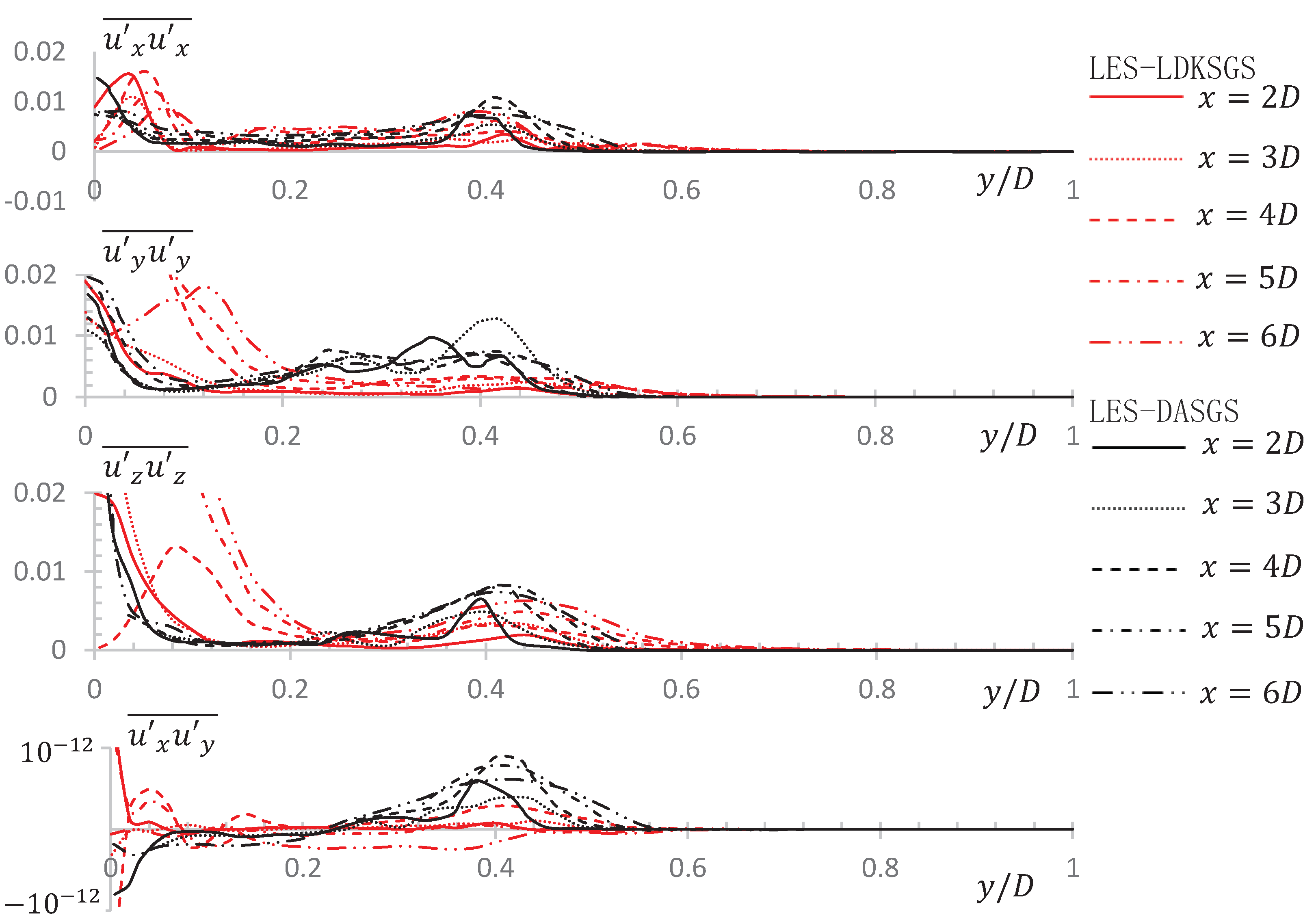
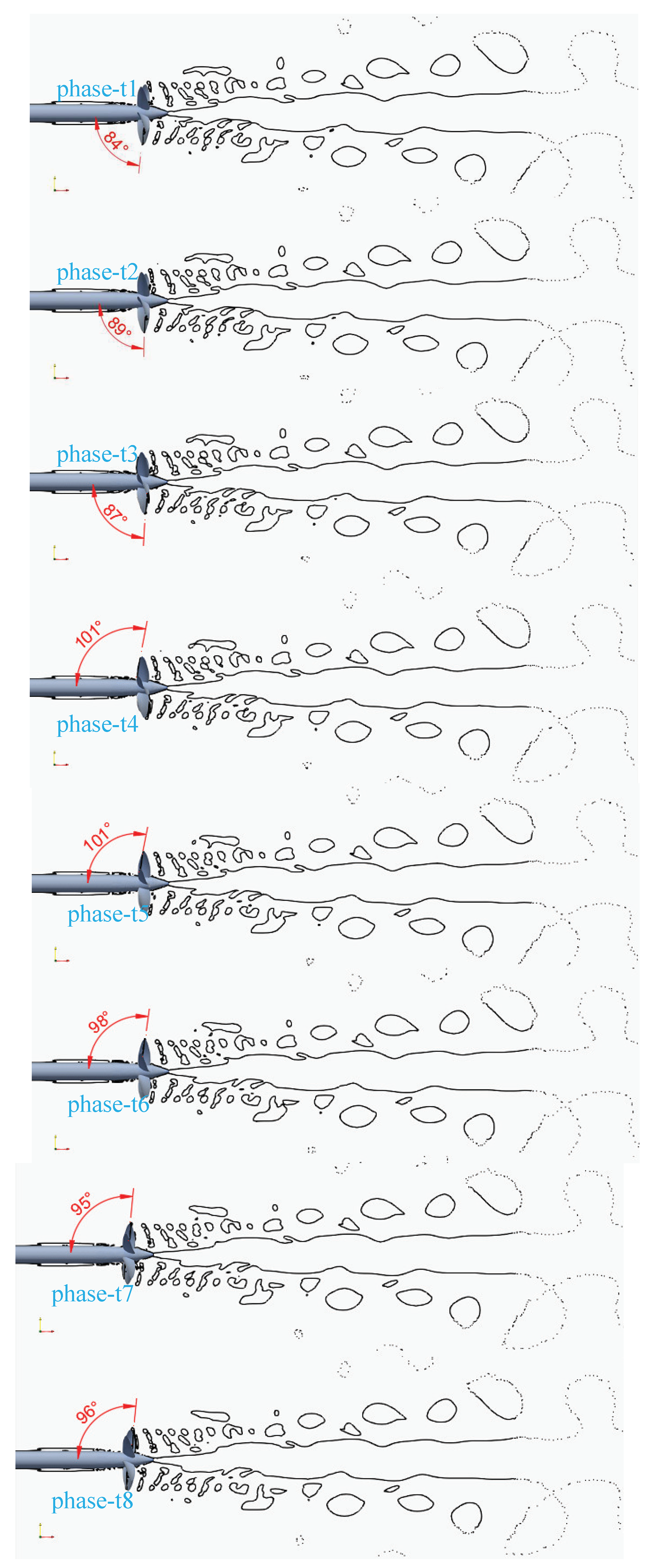
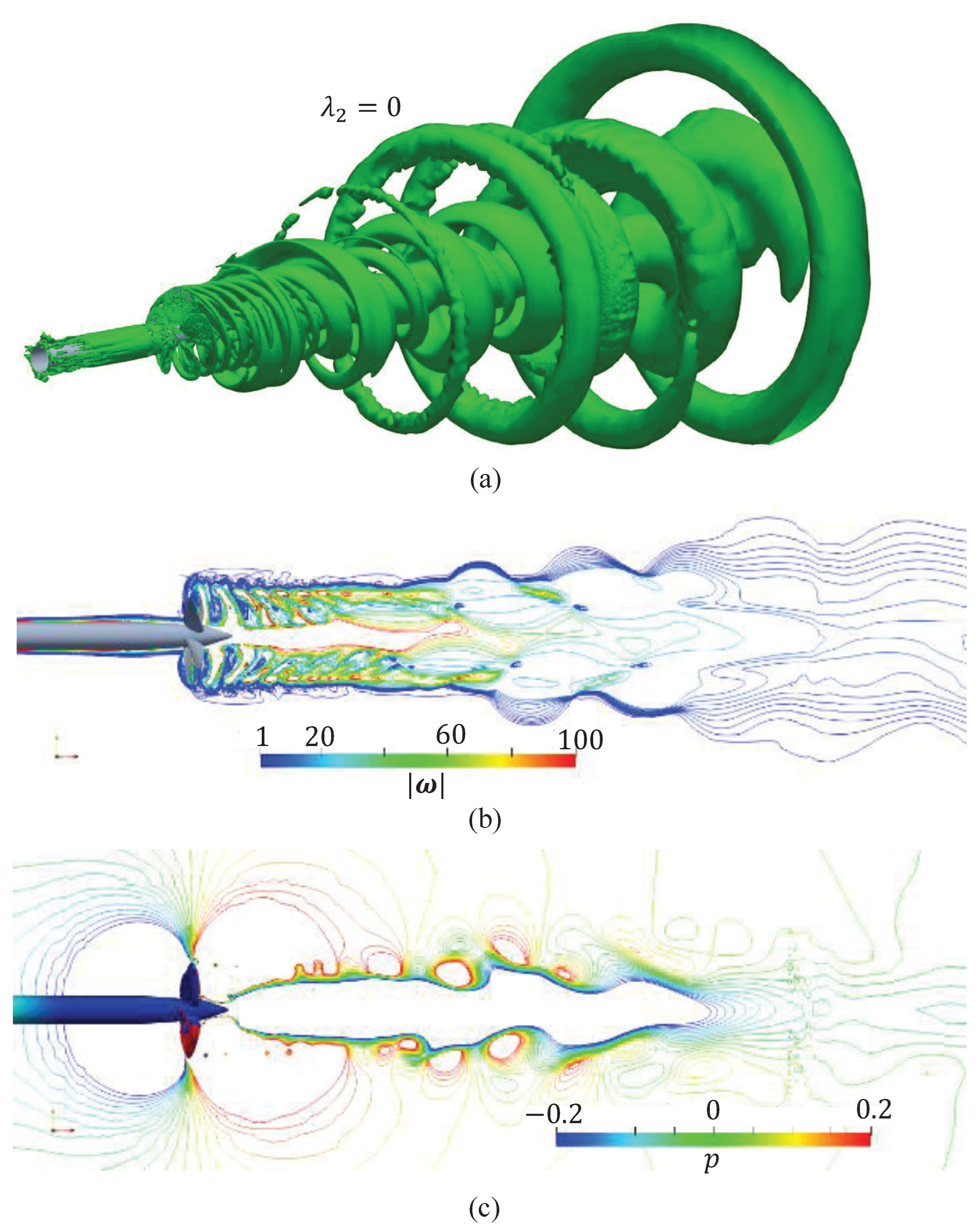
| Name | Grid Filter Level | Test Filter Level | |||
|---|---|---|---|---|---|
| filtered | resolved | filtered | resolved | ||
| kinetic energy | |||||
| dissipation rate | |||||
| length scale | |||||
| strain rate | unavailable | unavailable | unavailable | ||
| stress tensor | |||||
| Region | Cell Scales: (with about Total 8.5 Million Cells) |
|---|---|
| Region 0 (double-dashed line) | 0.125D |
| Region 1 (dashed line) | 0.015625D |
| Region 2 (dotted line) | 0.0078125D |
| Case | Turbulent Model | Advance Coefficient J | Number of Grids |
|---|---|---|---|
| Case 1 | LES-LDKSGS | 0.889 | ∼8.5 million |
| Case 2 | LES-LDKSGS | 3 | ∼8.5 million |
| Case 3 | RANS-kEpsilon | 0.889 | ∼8.5 million |
| Case 4 | RANS-kEpsilon | 0.889 | ∼3.07 million |
| Case 5 | RANS-kEpsilon | 0.889 | ∼1.15 million |
| Case 6 | RANS-kEpsilon | 0.889 | ∼38,000 |
| Case 7–24 | RANS-kEpsilon | 0.1, 0.2, 0.3, 0.4, 0.5, 0.6, 0.7, 0.8, 0.9, 1, 2, 3, 4, −0.1, −1, −2, −3, −4 (1) | ∼38,000 grid cells |
| Case 25–32 | RANS-kEpsilon | −1, −2, −3, −4, 1, 2, 3, 4 (1) | ∼38,000 |
| Case 33–42 | RANS-kEpsilon | 0.1, 0.2, 0.3, 0.4, 0.5, 0.6, 0.7, 0.8, 0.9, 1 (2) | ∼38,000 |
| Experiment | Relative Error ()% * | Relative Error ()% * | ||||
|---|---|---|---|---|---|---|
| LES-LDKSGS (case1) | −0.201 | (0.0, 11.6, 4.7) | 0.041 | (2.6, 7.8, 2.3) | ||
| RANS-kEpsilon (case3) | −0.194 | (3.5, 7.8, 8.1) | 0.042 | (0.2, 10.5, 0.0) | ||
| LES-DASGS [3] | −0.21 | (4.5, 16.7, 0.5) | 0.041 | (2.6, 7.8, 2.3) | ||
| OW (Jessup et al., 2004) | −0.201 | - | 0.0421 | - | ||
| WT (Jessup et al., 2006) | −0.18 | - | 0.038 | - | ||
| OW (Hecker and Remmers, 1971) | −0.211 | - | 0.042 | - |
| No. | Criterion for Vortex Identification |
|---|---|
| 1 | Local pressure minimum |
| 2 | Pathline and streamline |
| 3 | Vorticity magnitude |
| 4 | Existence of complex eigenvalues of |
| 5 | Second invariant Q of and kinematic vorticity number |
| 6 | Eigenvalues () of () |
Disclaimer/Publisher’s Note: The statements, opinions and data contained in all publications are solely those of the individual author(s) and contributor(s) and not of MDPI and/or the editor(s). MDPI and/or the editor(s) disclaim responsibility for any injury to people or property resulting from any ideas, methods, instructions or products referred to in the content. |
© 2023 by the authors. Licensee MDPI, Basel, Switzerland. This article is an open access article distributed under the terms and conditions of the Creative Commons Attribution (CC BY) license (https://creativecommons.org/licenses/by/4.0/).
Share and Cite
Young, L.; Zheng, X. Application of a Local Dynamic Model of Large Eddy Simulation to a Marine Propeller Wake. Appl. Sci. 2023, 13, 8324. https://doi.org/10.3390/app13148324
Young L, Zheng X. Application of a Local Dynamic Model of Large Eddy Simulation to a Marine Propeller Wake. Applied Sciences. 2023; 13(14):8324. https://doi.org/10.3390/app13148324
Chicago/Turabian StyleYoung, Lien, and Xing Zheng. 2023. "Application of a Local Dynamic Model of Large Eddy Simulation to a Marine Propeller Wake" Applied Sciences 13, no. 14: 8324. https://doi.org/10.3390/app13148324
APA StyleYoung, L., & Zheng, X. (2023). Application of a Local Dynamic Model of Large Eddy Simulation to a Marine Propeller Wake. Applied Sciences, 13(14), 8324. https://doi.org/10.3390/app13148324







